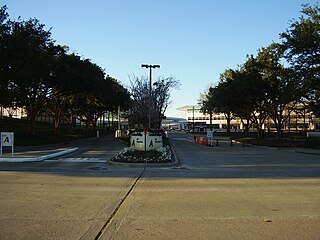
Sinclair Oil Corporation was an American petroleum corporation, founded by Harry F. Sinclair on May 1, 1916, as the Sinclair Oil and Refining Corporation by combining the assets of 11 small petroleum companies. Originally a New York corporation, Sinclair Oil reincorporated in Wyoming in 1976. The corporation's logo featured the silhouette of a large green sauropod dinosaur, based on the then-common idea that oil deposits beneath the earth came from the dead bodies of dinosaurs. It was ranked on the list of largest privately owned American corporations. It owned and operated refineries, gas stations, hotels, a ski resort, and a cattle ranch.

The National Register of Historic Places in the United States is a register including buildings, sites, structures, districts, and objects. The Register automatically includes all National Historic Landmarks as well as all historic areas administered by the U.S. National Park Service. Since its introduction in 1966, more than 90,000 separate listings have been added to the register.

Conoco Inc. was an American oil and gas company that operated from 1875 until 2002, when it merged with Phillips Petroleum 66 to form ConocoPhillips. Founded by Isaac Elder Blake in 1875 as the "Continental Oil and Transportation Company". Currently the name Conoco is a brand of gasoline and service station in the United States which belongs to Phillips 66 following the spin-off of ConocoPhillips' downstream assets in May 2012.

Art's Auto is a historic former service station at 5–7 Lonsdale Avenue in Pawtucket, Rhode Island. It is a single-story brick structure with a flat roof and a series of towers capped by pointed roofs. It was erected as an automotive service station in 1927–28 for Arthur Normand at a time when gasoline producers competed, in part, by the shape and style of their service stations. This station is one of two stations known to survive from this period in the state. Its front facade has a dramatic presentation, with square towers topped by pyramidal roofs at the corners, and a projecting round bay in the center topped by a conical roof, with windows arrayed around the bay and on its flanks. The building is currently used as an office for Anchor Financial. Art's Auto was listed on the National Register of Historic Places in 1978.

The Arlington Gaslight Company is an historic industrial complex in Arlington, Massachusetts. It is one of the town's few large-scale examples of industrial architecture, built for a local fuel company in 1914. The three-building facility presently houses the town's public works department. It was listed on the National Register of Historic Places in 1985.

The Jenney Stockade was a stage station on the Cheyenne-Deadwood route near Newcastle, Wyoming. It also served as a headquarters for a military expedition to the Black Hills to survey the area for minerals. The site was first occupied in 1857, when Lieutenant G.K. Warren and geologist Dr. F.V. Hayden set up a small base camp for their expedition. In 1875, the site was reoccupied by a party of 75 miners and geologist, accompanied by 432 soldiers, who built a log fort, named Camp Jenney after the chief geologist, Professor Walter P. Jenney.

The Masonic Temple in downtown Casper, Wyoming is a Masonic hall, built in 1914 during a boom time initiated by the development of the Salt Creek Oil Field. Located on a corner site, the temple remains essentially as it was designed by Casper architect Homer F. Shaffer. The four story light-colored brick building rests on a raised basement and is topped by a crenelated parapet. The original windows have been replaced with vinyl units but retain the one-over-one appearance of the originals. Windows extend over the west and south sides. The north side is blank, while the east side is the building's rear facade and has fire escapes and a few windows.

The Union Pacific Railroad Complex in Evanston, Wyoming, was built to serve the Union Pacific Railroad main line running through Evanston. The complex's brick buildings were built in 1912–13, with frame buildings spanning the period from 1871 to the 1920s. The complex features a roundhouse with 27 stalls built during the 1912 improvement phase, replacing an earlier roundhouse built in 1871. The complex was the chief service point on the UP main line between Ogden, Utah, and Green River, Wyoming.

St. Mary's Cathedral is the cathedral and parish church in the Diocese of Cheyenne located in Cheyenne, Wyoming, United States. It was listed on the National Register of Historic Places in 1974.

The Young Brothers Chevrolet Garage is a site on the National Register of Historic Places located in Chinook, Montana. It has also been known as AAA Garage, as Taylor Motor Company, as Tilleman Chevrolet, and as Precision Auto Body. It was added to the Register on August 16, 1994. It is a stucco building with an asphalt roof.
William R. Dubois (1879-1953) was an American architect. He was a prolific architect in Wyoming and nearby states.

The Jackson Conoco Service Station is a one-story brick structure located in El Reno, Oklahoma. Listed on the National Register of Historic Places in 2004, it was constructed by the Continental Oil Company in 1934 as a service station to serve the increasing automobile traffic along Route 66. Conoco built and operated many such facilities in the 1930s, all identical except for the positioning of the service bay; one other example is listed on the NRHP in Oklahoma, the Spraker Service Station in Vinita.

The Rainbow Conoco at 400 Main St. in Shelby, Montana, also known as Joe's, was built in 1936. It was listed on the National Register of Historic Places in 1994.

The Cheyenne Flour Milling Company, also known as the Standard Oil Company and Salt Creek Freightways, is an early warehouse building in Cheyenne, Wyoming. The structure was built in 1927 to house goods brought to and from Cheyenne by the Union Pacific Railroad in an industrial section of Cheyenne as a flour mill, replacing structures that had performed similar functions since 1915. By 1931 the building was shared by a warehouse for electrical parts for the Mountain States Telephone and Telegraph Company, a potato chip factory and a chemical products company. In 1937-38 the Standard Oil Company started to use the warehouse for bulk petroleum products storage, continuing to 1963. From 1963 the building was used by Salt Creek Freightways, which had shared use from 1936. In 1973 it became a plumbing parts warehouse, and by 2003 was owned and used by a general contractor.

The Huning Highlands Conoco Service Station is a historic gas station in the Huning Highlands neighborhood of Albuquerque, New Mexico. It was built in 1937 by the Continental Oil Company (Conoco) and is notable as a well-preserved example of the automobile-oriented development that shaped the city during the mid-20th century. The building was listed on the New Mexico State Register of Cultural Properties and the National Register of Historic Places in 2006.
The Continental Oil Company Filling Station at 35 First Ave. N. in Kalispell, Montana was a historic filling station built around 1932 for the Continental Oil Company which was listed on the National Register of Historic Places in 1994. It has since been demolished.

The Marland Filling Station at 102 South Wood in Hominy, Oklahoma was built in 1922. It was listed on the National Register of Historic Places in 2002.

The Hughes Conoco Service Station, at 400 SW. Taylor St. in Topeka, Kansas, was listed on the National Register of Historic Places in 2011.
The Spraker Service Station, at 240 S. Wilson St. in Vinita, Oklahoma, United States, is a Tudor Revival-style Conoco filling station which was built in 1927. It was listed on the National Register of Historic Places in 1995.

















